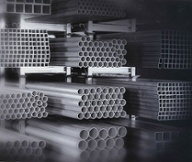Stainless steel has become such a common metal that it’s used in everything from home appliances and cutlery to chemical and pharmaceutical, medical, and oil and gas applications. It is so commonly seen by everyone that it is difficult to remember that there was a time when stainless steel did not exist.
A History Lesson
Through the early 1900s, advances and discoveries were made that led to the industrialization of stainless steel. In 1912, an English researcher named Harry Brearley discovered stainless steel alloy while searching for ways to create gun barrels that were resistant to corrosion. After applying for a patent, Brearley discovered that an American named Elwood Haynes had also applied for a patent. Brearley and Haynes pooled their funds and formed the American Stainless Steel Corporation.
German metallurgists were also experimenting with adding nickel and created stainless steel that was softer, easier to work and more resistant to acids. Combined with Brearley and Haynes’ discoveries, two types of stainless steel had been invented: the “400” series of martensitic and the “300” series of austinsitic steel.
After World War I, the modern 18/8 form of stainless steel was invented, along with other combinations by Brearley’s successor, but it is the 18% chromium and 8% nickel combination that still dominates the stainless steel industry today.
Composition
The term “Stainless Steel” is a generic term covering a range of rust and corrosion resistant grades of steel. Primarily, stainless steel should be able to resist corrosion while being used within application specifications. To do this, stainless steel relies on:
- Nickel – Nickel is known for its corrosion resistance, even at high temperatures, as well as its ductility and strength. Approximately 65% of the nickel used in the Western World is in stainless steel, which is often composed of around 8% nickel.
- Chromium – Chromium is
a hard and brittle metal, which does not tarnish when exposed to air. It forms a thin oxide layer which will protect the metal below. Stainless steel is often composed of around 18% chromium.
- Other Alloys – Other alloys can be included in stainless steel to give it varying properties and resistances. The exact make-up of the material will always depend on its application.
Common Usage
Stainless steel has a number of different applications, and comes in a wide variety of grades. When choosing a stainless steel for a project, it is important to understand what it will be used for, and then use the appropriate grade of material.
There are a number of different types of stainless steel, which makes it important not to think of it as one single material, but several. Some examples of stainless steel include:
- Type 304 (a.k.a. A2 Stainless Steel) – 304 is the most common grade of stainless steel contains 18% chromium and 8% nickel. It is one of the most commonly used stainless steel alloys and is used in a wide variety of applications, from tanks to food processors, beer brewing and wine making. It is also used in architectural panels, heat exchangers and the maritime industry. It is known for its forming and welding properties, and excellent toughness and ease of cleaning.
- Type 316 – This is the second most commonly used stainless steel after Type 304. The addition of molybdenum means the prevention of specific types of corrosion. It has resistance to chloride corrosion and is used for building nuclear reprocessing plants. Many watches are made of this grade of stainless steel. Food and surgical applications use Type 316 and it is also known as “A4,” or “Marine Grade” stainless steel.
- Type 420 – This grade is a martensitic, high-carbon stainless steel similar to Brearley’s original rustless steel. It has excellent polishability and high strength at room temperature, or slightly elevated temperature. It is used in cutlery, surgical instruments, scissors, gears and ball bearings. It contains 12% chrome steel and has higher strength and hardness, not to mention better wear resistance.
- Type 440 – Type 440 is a higher grade of cutlery steel which has better edge retention when treated properly. It is also able to be hardened to “Rockwell 58” hardness, making it one of the strongest stainless steels available. It is resistant to fresh water, crude oil, gasoline, perspiration, alcohol and foodstuffs, and used for high-end cutting and crushing machines. It has limited weldability and special steps must be taken to avoid damaging the alloy.
Stainless steel has been around for 100 years now, and has become a part of everyday life. From the utensils you use to eat to architecture and aircraft, this alloy is highly trusted. While the composition varies somewhat, you can be sure that the steel you have will stand up to the applications for which you are using it.
Learn more about stainless steel at Continental Steel.


